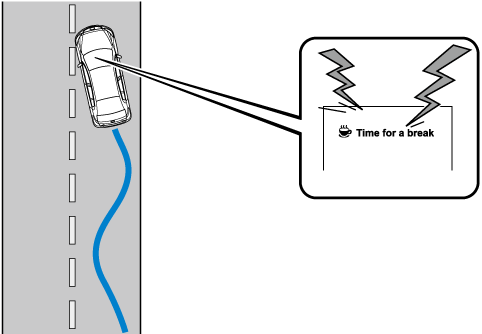Driver Attention Alert (DAA) (Some Models)
The Driver Attention Alert (DAA) is a system which detects driver fatigue and decreased attentiveness, and encourages the driver to take a rest.
When the vehicle is driven inside traffic lane lines at about 65 to 140 km/h (41 to 86 mph), the Driver Attention Alert (DAA) estimates the amount of accumulated fatigue and decreased attentiveness of the driver based on the information from the Forward Sensing Camera (FSC) and other vehicle information, and encourages the driver to take a rest using an indication on the active driving display and a warning sound.
Use the Driver Attention Alert (DAA) on expressways or highways.
Refer to Forward Sensing Camera (FSC) (Search).

Do not rely completely on Driver Attention Alert (DAA) and always drive carefully:
The Driver Attention Alert (DAA) detects driver fatigue and decreased attentiveness and encourages the driver to take a rest, however, it is not designed to prevent the vehicle from straying. If you rely too much on the Driver Attention Alert (DAA) it could lead to an accident. Drive carefully and operate the steering wheel appropriately.
In addition, the system may not be able to detect driver fatigue and decreased attentiveness correctly depending on the traffic and driving conditions. The driver must take sufficient rest in consideration of safer driving.


-
The Driver Attention Alert (DAA) operates when all of the following conditions are met.
-
The vehicle speed is about 65 to 140 km/h (41 to 86 mph).
-
The system detects white (yellow) lane lines.
-
The system has completed learning of the driver’s driving data.
-
-
The Driver Attention Alert (DAA) does not operate under the following conditions.
-
The vehicle speed is less than about 65 km/h (41 mph).
-
The vehicle speed exceeds about 140 km/h (86 mph)
-
The vehicle is making a sharp turn.
-
The vehicle is changing lanes.
-
-
The Driver Attention Alert (DAA) may not operate normally under the following conditions.
-
White (yellow) lane lines are less visible because of dirt or fading/patchiness.
-
The vehicle is jolted or swayed continuously by strong winds or rough roads.
-
The vehicle is driven aggressively.
-
When making frequent lane changes.
-
-
The Driver Attention Alert (DAA) detects driver fatigue and decreased attentiveness based on the driving data when the vehicle is driven at about 65 to 140 km/h (41 to 86 mph) for about 20 minutes. The driving data will be reset under the following conditions.
-
The vehicle is stopped for 5 minutes or longer.
-
The vehicle is driven at less than about 65 km/h (41 mph) for about 30 minutes.
-
The ignition is switched off.
-
-
After the Driver Attention Alert (DAA) has displayed the first message encouraging rest, it does not display the next one until 45 minutes have passed.




 Read this first
Read this first



















